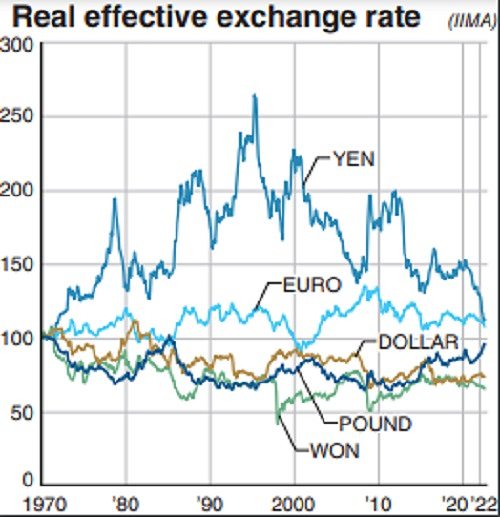Rise and fall of the yen is entwined with state of the economy

8:00 JST, October 8, 2022
As the yen is weakening to historically low levels, tourists visiting Japan from overseas seem to think that goods and services here are “cheap.”
The world has completely changed since the days of “expensive Japan.”
Younger generations of Japanese may not be familiar with this, but from the 1980s to the 1990s, prices in Japan were much higher than those in Europe and the United States. In 1995, a survey by the Economic Planning Agency showed domestic-foreign price differentials that are truly remarkable by today’s standards.
The overall price level in Tokyo was 1.59 times that of New York and 1.52 times that of London. Specifically, food prices were 1.77 times higher than in New York, clothing and footwear prices were 1.93 times higher, and durable consumer goods prices were 1.47 times higher. Everyday products were more expensive across the board, a phenomenon that became a major political issue in Japan.
The value of the yen was at historic highs at the time, but this was not the only reason for high prices in Japan. The problem was the closed Japanese market.
Japan was the world’s second-largest economy for 42 years, from 1968 to 2009, following rapid growth after World War II.
However, Japanese tourists who traveled to Europe and the United States saw that people in the West lived more affluent lives, with the prices of daily goods and food lower than in Japan.
This gave rise to the expression, “Japan has become wealthy, but the Japanese people cannot feel that wealth.”
When Japanese manufacturing dominated the world, the Japanese people were obsessed with such thoughts.
The issue of the domestic-foreign price gap was a subject of the Japan-U.S. Structural Impediments Initiative, held from 1989 to 1990, when trade friction between the two countries was intensifying.
Generally, fair and free competition means there are no extreme price differences in traded goods, except for those related to transportation costs. Because goods are exported from countries where they cost less to countries where they cost more, price differences should eventually even out.
The U.S. side in those days argued that easing regulations and opening the market would benefit both U.S. companies and Japanese consumers.
How was the price gap between domestic and foreign prices subsequently corrected?
At the time, Japan had high productivity in the manufacturing sector but relatively low productivity in the distribution and service sectors. The strength of the manufacturing industry was a factor behind the strong yen, but the domestic service sector had somewhat higher prices. This situation led to price differentials between Japan and other countries.
Due to gaiatsu (foreign pressure) applied by the United States and other factors, measures such as deregulation have improved productivity in the service sector to some extent, and prices have become cheaper. This has been a positive development for Japan.
However, there were more significant factors, such as chronic deflation, and delayed structural reforms.
Japan has been mired in a prolonged period of deflation since the late 1990s, and it was not until 2013 that the Japanese government expressed the view that the country was not in deflation.
It was in 2007 that the Annual Report on the Japanese Economy and Public Finance stated that “after a long period of falling prices, the price gap between domestic and foreign prices is finally disappearing.”
Let us look at international comparisons of the yen’s appreciation in the 1990s.
The graph accompanying this column compares the real effective exchange rates of the Japanese yen, the U.S. dollar, the euro, the British pound and the South Korean won over a half-century, using their 1970 values to set a baseline of 100, showing the relative strength and weakness of the currencies. While the other currencies do not deviate significantly from 100 over a long period, the yen shows a markedly unusual curve.
The real effective exchange rate does not compare the value of two currencies, such as the yen and the dollar, but rather indicates the strength of one currency relative to various other currencies. It is calculated based on the volume of trade transactions with the partner countries. “Real” means that it excludes the effects of inflation.
I think it is noteworthy about this graph that the index for the Japanese yen rose to over 250 in the mid-1990s and then declined for an extended period.
Even during the historically strong yen phase in 2011, the yen was not as strong as it was in the mid-1990s.
Masashi Hashimoto, senior economist at the Institute for International Monetary Affairs (IIMA), analyzed the graph and said, “We can consider the yen’s unique curve as appearing against the backdrop of Japan-U.S. trade friction and other factors.”
Hashimoto considers it unfortunate that the market corrected the yen’s overvaluation to a more appropriate level only after inflation remained dormant for a long time. Also, after 30 years of delay in Japan’s structural reforms, Japanese companies lost competitiveness.
Frustrated by the flood of products from Japanese manufacturers, U.S. officials made comments that amounted to intervening in the foreign exchange market to weaken the competitiveness of Japan’s export manufacturing industry by strengthening the yen. As a result, the yen became more overvalued in the mid-1990s.
In response to the super-strong yen, Japanese exporters maintained price competitiveness by cutting costs. As a result, cost-cutting became the central behavioral principle of Japanese companies, and a deflationary mindset spread throughout the country.
The Japanese economy has been at the mercy of exchange rates and prices and is now suffering from high prices due to the weak yen.
The Japanese government and the Bank of Japan intervened in the foreign exchange market on Sept. 22. It was the first time in 24 years for them to buy yen and sell dollars to correct the sharp depreciation of the yen and appreciation of the dollar.
Former Vice Minister of Finance for International Affairs Naoyuki Shinohara explained two aspects of the current yen depreciation.
“One is differences in monetary policy between the U.S. and Japan, and the other is the declining competitiveness of the Japanese economy.”
He also noted that “if Japanese authorities intervene in the foreign exchange market with a target level of defense for the exchange rate, the U.S. will not tolerate it.”
Currency intervention can be effective in putting the brakes on speculation, to a degree.
But it is powerless to counteract the declining national strength of the Japanese economy.
The yen has reflected the rise and fall of the Japanese economy.
At the same time, Japan’s economy is repeating its history of not coping well with currency fluctuations.
Therefore, we must return to the basics.
We must strengthen the competitiveness of Japanese companies.
The semiconductor industry is the most symbolic of the rise and fall of Japan’s manufacturing sector. South Korea’s Samsung Electronics and other companies have overtaken it, and the Japanese semiconductor sector is no longer the prosperous industry it once was.
The late Yasuo Naruke, the first president of Kioxia, which is still a vital semiconductor manufacturer in Japan, told The Yomiuri Shimbun in an interview at the end of the 1989-2019 Heisei era: “The Japanese semiconductor industry has gone from being the top runner back to being a challenger.”
Challenger spirit.
That is what Japan needs today.
Political Pulse appears every Saturday.

Akihiro Okada
Okada is an editorial writer for The Yomiuri Shimbun.
"Editorial & Columns" POPULAR ARTICLE
JN ACCESS RANKING





